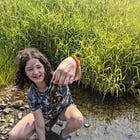Learning language models aka ai models are having a world changing impact already, and will be extremely disruptive in the very near future. You can’t even spell Maisa without ai. There is, of course, some natural fear, but also amazement at using this superpower to access information. I think these ai tools, are going to be very helpful in assisting parents with advocating for their children and themselves. I am trying to learn how these tools can help and conversely how they might harm. Notably, I am learning how they can be used to effectively turn this tool into an energy multiplier for advocacy. I will get to that, but first an anecdote.
Maisa would tease me for my job, and connection to the world of agricultural finance. She would call me farmer Yams, and loved that I had this weird background where I know a few things about farming, having grown up on a farm. My Dad was the citizen farmer and rancher in the family. We joked that he was born a 100 years too late. Here he is checking out the cows with Conor and Maisa. I remember how funny he thought it was that the kids had stepped in cow pies and how surprised Samia would be. Cow pies are an occupational hazard on the farm, which is why it is nice to have a shower a few steps from the door.
The funny thing (probably only to me) is that before ai was universally accepted as short for artificial intelligence, it was something different in the agricultural world, artificial insemination. An ai guy in agriculture is a different job entirely. We humans have been trying to eek out a few more efficiencies since Norman Bourlag set off the green revolution. Natural vs Artificial will always be a heated debate, but the hand of natural selection can be really cruel as well. As science fiction becomes science, we struggle to balance the moral, ethical and societal implications of these advancements. Whether it is ai or farmer ai.
Institutions also have a form of institutional Darwinism. They grow and grow and end up with many of their own maladaptive parts and mutations. How to reform and remake these? From my last post 127 hours, it is clear that our systems can and should do a better job helping those in mental health distress and those at obvious risk of mental health distress. Institutional evolution has become bloated, maladaptive to those it is intended to help, and in need of some reformation that would make Martin Luther blush.
To ignore an IDEA
Many parents don’t know about IDEA, or the duties that schools have to find, assess, and accommodate school age children with disabilities. Some parents have to go to war with the schools to try and get their kids properly assessed, and accommodated. The process grinds on for years and even if the parents “win”, they still lose. They lose time. Years of time for their child in their formative years. And the kids accumulate damage the whole way through. These hurts are often psychic. Out of sight and out of mind. Or at least out of the mind of the schools. Schools aren’t monolithic. They are an amalgamation of the many who do an absolutely amazing job for kids under their purview. But I bet many feel they have to fight the system in order to so.
This treatment is in abrogation of legal duties that school systems have to children in their district. IDEA (Individuals with Disabilities Education Act) mandates schools identify, locate, and evaluate all children with disabilities from birth to age 21 who are in need of special education and related services. An example is that it is possible to be both gifted and disabled or what is often termed as “twice-exceptional.” Twice exceptional (2e) children are those who are considered “gifted or talented” in one or more areas while simultaneously having one or more learning disabilities, ADHD, autism, emotional or behavioral issues, or other disabilities. Samia wrote beautifully about the curses of so called “giftedness.”
Luckily Idaho State Department of Education recently revised their special education manual. The previous versions of the manual helpfully, but poorly define twice exceptional as the following:
Which even if poorly defined, it might still be useful if they ever provided a morsel of guidance in how to identify, accommodate, support twice-exceptional kids in the manual. A simple word search indicates that the term is only defined, and never used again. Helpful! The state department of education refused to fix any of this, or even typos, when I brought it to their attention. Good thing they are setting standards for what our children should learn in school.
Schools have a Legal Duty to “Child Find”
Identification:
School’s ‘Child Find’ responsibility under IDEA is an affirmative mandate for schools to identify all children with disability, including twice-exceptional students by identifying, accommodating and recognizing both their giftedness and their disability.
I have seen principals and administrators and others argue that it is not applicable, but it is actually settled that they have this affirmative duty.
The OSEP Memo 15-08, referencing the Letter to Delisle (December 20, 2013), emphasizes that IDEA requires local educational agencies (LEAs) to evaluate all children suspected of having a disability, including those with high cognition (2e students), as outlined in 34 CFR §300.8. This includes children with specific learning disabilities, emotional disturbance, or other mental health conditions, regardless of their intellectual gifts. Don’t take my word for it, read the letter from the US Dept. of Education here.
I suppose that the Idaho Dept. of Education and school districts could plead ignorance. Which is difficult to plead as the letter went out to them all. Their ability to plead ignorance evaporates with the fact that the Idaho Department of Education wrote an entire manual on the importance of identifying and supporting 2e kids in Idaho. Even has Tom Luna’s name on it.
Here is the original manual in the dustbin of historical special education half measures. Writing it and following it are not the same. This 2e specific manual has a much better definition of 2e.

It often appears to me that school districts perversely focus more on which ribbon of the month they should bandy around for the perception of caring, rather than waste a scintilla of energy actually doing what they are supposed to do. Token gestures are cheaper than actions I guess. Cheaper, for them, not for my family or other families predictably being harmed by their willful disregard and blind indifference for the law. What I have painfully realized is that they aren’t going to listen to me or my wife. No matter how persuasively and diligently we advocate for our kids. They will only listen if we channel our inner Hooville and harmonize our voices so that our children’s needs can not be ignored.
Time to AI an Idea
Grok is a bunch of Nvidia chips sitting in a warehouse in Memphis Tennessee that have linked up in a hive mind. Trained on the same information available to us, yet perhaps, better at synthesizing it without ego interfering, I often feel more empathy care and support from this amalgamation of silicon, copper, and metal than I do from the institutions that are ostensibly there to help. Maybe rather than trying to weaponize an ai bot to harangue parents and children over their attendance, they should use these tools to ask some questions about IDEA, ADA (“American with Disabilities Act”), child find, autism, special education. Really anything. I am using some of these tools to do legal research, as there comes a time when the only way to enact change in the school system is to litigate. They say justice is blind, but of course that would probably be a disability they would also find a way to ignore.
Child Find to Prevent Another Lost Generation
School districts have an affirmative duty under federal law to “child find.” This duty would entail a comprehensive assessment of a child in the full range of disability. This duty is affirmatively on the school districts, whether or not parents raise formal concerns or ask for a comprehensive assessment for disabilities. It makes sense that the affirmative duty is on the schools as schools should be the experts and are obviously in the best position to recognize disability in the children under their purview. It is also obvious that they are failing this duty. So, if you have any concerns over your children, formally raise them with a written letter. I had Grok assist me. If any parents have gone through the process, please let us know how to make it better and more effective.
Below is a letter (or email) template can be adapted to your specific situation. It incorporates the Individuals with Disabilities Education Act (IDEA) Child Find mandate and emphasizes the risks of failing to identify and support a child with a disability. If I get 5 shares of this post we will put the form letter on our webpage for people to use. Let’s see who is better at coordinating. Nvidia servers or us?









